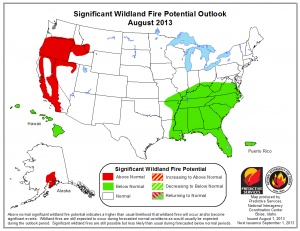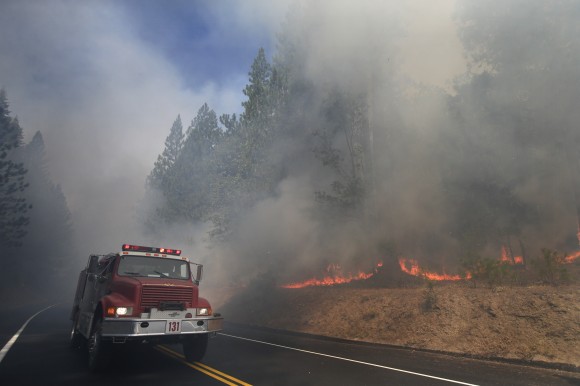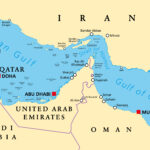The week-and-a-half-old wildfire in Yosemite is seen by some as a harbinger of what could be a “worst case scenario” when California enters its typical wildfire season in October – continued drought, lots of unburned fuel and a weather outlook that offers little hope for early precipitation.
The 180,000-acre-and-growing Rim Fire is currently moving along the remote northwest corner of Yosemite National Park, fueled by dry, warm conditions and winds gusts between 15 to 30 mph.
It has only burned an estimated 20 structures so far, but it has come within miles of water and hydropower sources for San Francisco and has cost the city $600,000 for replacement electricity, officials said.
The fire on Tuesday was near the Hetch Hetchy Reservoir, which is the source of most of San Francisco’s pure drinking water, as well as power for a number of city buildings, including the airport, according to the U.S. Forest Service. The San Francisco Public Utilities Commission has shut down two hydroelectric stations fed by water from the reservoir and cut power to more than 12 miles of lines as a precaution.

More than 3,700 personnel are involved with fighting the Rim Fire, which is 20 percent contained, according to fire officials.
While the cause of the fire is currently under investigation, experts are confidently giving partial blame for the size of the fire to the extended drought in the West.
“Certainly the drought overall for a number or years has been quite intense in the western states, and certainly this past summer,” said Tomas Girnius, a senior scientist at catastrophe modeling firm AIR Worldwide in Boston, Mass. “And it’s nowhere close to Santa Anna season.”
Drought severity figures from the National Oceanic and Atmospheric Administration place the area where the Rim Fire is raging under “extreme” or “severe” drought rankings continually since mid-May.
“The time before that wasn’t necessarily great either,” Girnius added.
California had less than 50 percent of its typical precipitation last year for the wet weather months, November to May, according to Roger Lamoni, a fire weather climatologist for NOAA’s Western region.
Like Girnius, Lamoni is turning his attention toward the state’s annual Santa Anna winds.
“As we go into the fall season, it’s basically Santa Anna time,” Lamoni said.
The Santa Annas are created by cool air from the Great Basin flowing rapidly out toward the warmer climes around the ocean, which can cause a drop in humidity and yield blustery winds that can stoke small wildfires into raging blazes.
“It’s like water pouring out of a pond into a lower elevation,” Lamoni said. “Relative humidity during Santa Anna days can drop to 5 percent, and the early Santa Annas can come when there are areas experiencing temperatures over 100 degrees.”
The plentiful fuel for the fires comes from consecutive dry seasons, such as last year, which has left the state with an abundance of “drought-stressed vegetation” that is receptive to any source of ignition, Lamoni said.
Such dry tender is what also enables fires to spread quite rapidly, he added.
These are among the considerations in the National Interagency Coordination Center’s National Significant Wildland Fire Potential Outlook issued for August. It calls for “above normal” conditions for most of California. The September report is due out the first of the month.
Adding to concerns is a neutral forecast for precipitation, meaning early rainfall before or during the October-through-November Santa Anna timeframe is less than likely.
Those concerns and the Rim Fire are the impetus for a group that provides insurance information to consumers to alert homeowners to increased potential of a rough fire season.
While the area of the Rim Fire is a lesser populated portion of the state, there are an abundance of homeowners living in high-risk areas, such as those in the wildland-urban interface, facing a potential scary couple of months, according to the Insurance Information Network of California.
According to a wildfire risk study of California last year conducted by IINC and Verisk Risk Solutions (ISO), the counties that comprise Yosemite National Park have some the highest percentages of homes in high wildfire risk areas.
Toloumne is at 80.14 percent, and Mariposa is at 81.4 percent, that report shows.
IINC was actively warning homeowners last year of the increased danger season.
“It’s worse now,” IINC spokesman Pete Moraga said. “We’ve had another year of pretty much drought in many areas.”
Comparing the potential for catastrophic losses with other states, Moraga noted that Colorado has had two consecutive seasons in which wildfires wrought record insured losses and record losses in terms of scale.
Yet the potential for losses in California eclipse those in Colorado, Moraga added.
“If you take the total number of high-risk homes in California, which is more than 2 million, that’s more than the total number of homes in Colorado,” he said.
For Moraga, Lamoni and Girnius the fuel, lackluster rainfall in the forecast and the potential for Santa Annas puts the “worst case scenario” phrase at the forefront of their conversations about the state’s wildfire season.
“The risk is there,” Girnius said. “We seem to be in conditions that would be very conducive to very catastrophic fires.”
Topics California Catastrophe Natural Disasters Wildfire Colorado
Was this article valuable?
Here are more articles you may enjoy.



 Liberty Mutual Posts $1.5B Net Income for Q1, Reversing Loss
Liberty Mutual Posts $1.5B Net Income for Q1, Reversing Loss  Viewpoint: The 10 Major Risks Shaping Insurance Today
Viewpoint: The 10 Major Risks Shaping Insurance Today  Pfizer Agrees to Settle More Than 10,000 Zantac Cancer Lawsuits
Pfizer Agrees to Settle More Than 10,000 Zantac Cancer Lawsuits  Three Insurers Reject Chevron’s $57 Million Claim for Iran Oil Seizure
Three Insurers Reject Chevron’s $57 Million Claim for Iran Oil Seizure 

